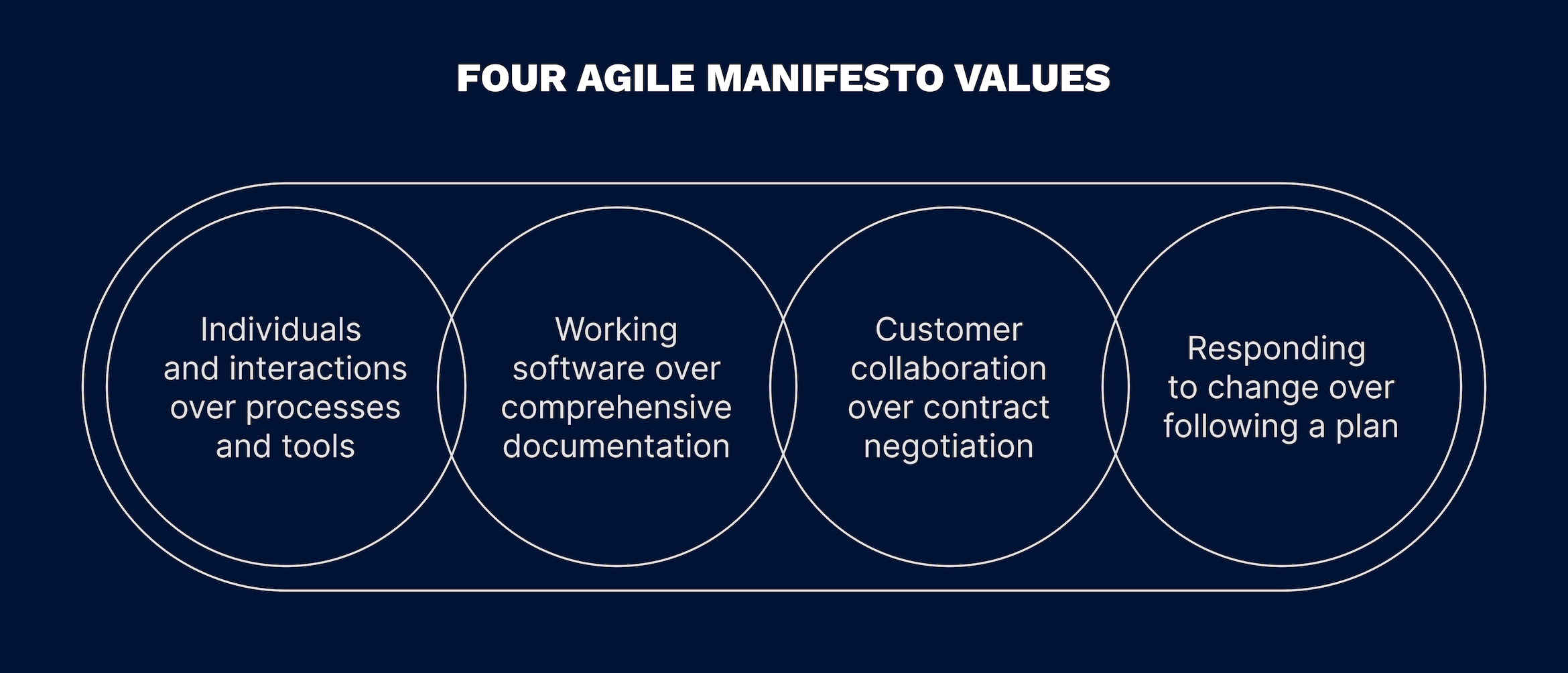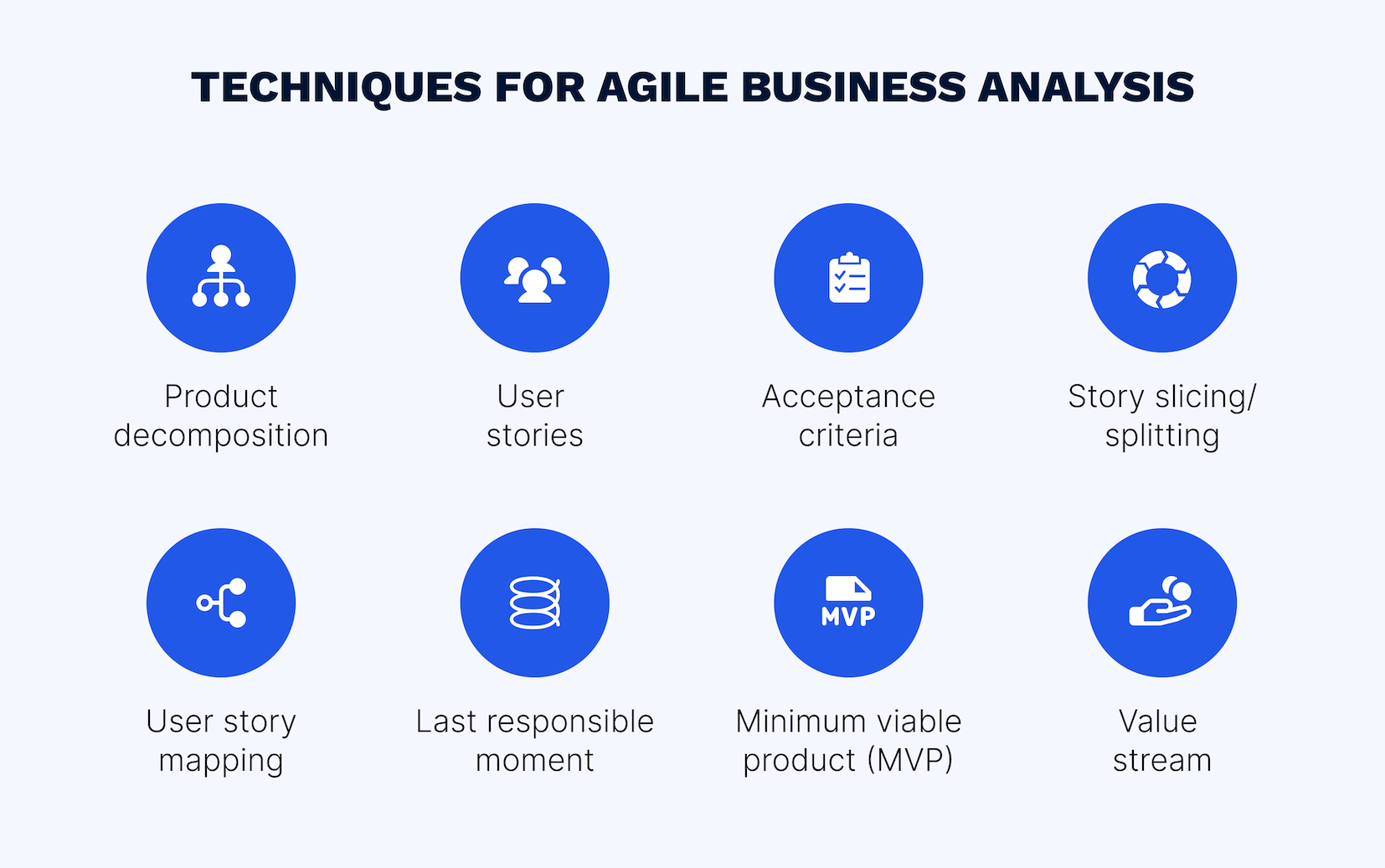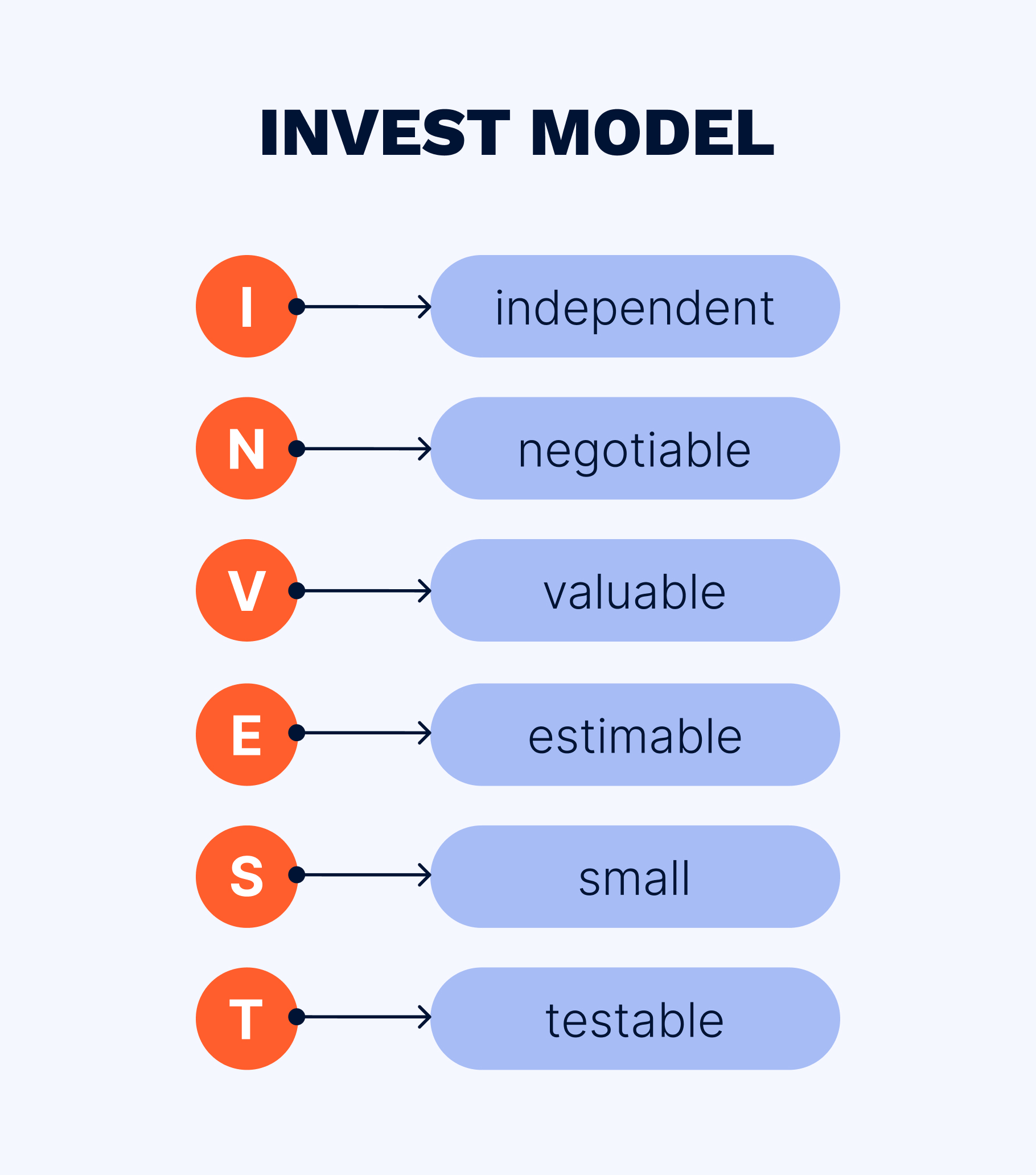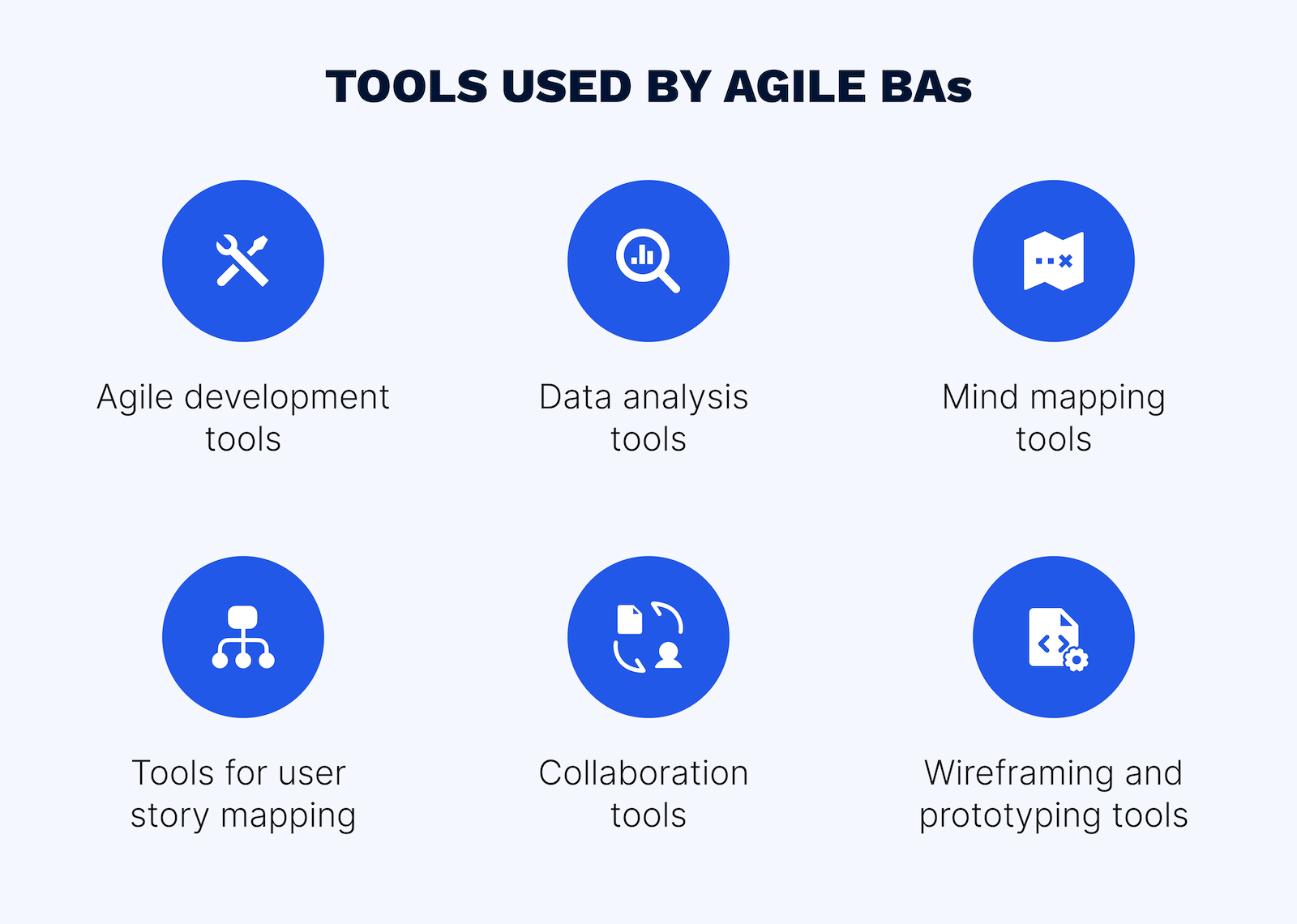
Contact us
Our team would love to hear from you.

Traditional business analysis methods, which are reliable and proven, are not always adaptable. This has led many organizations to adopt an agile business analysis approach that emphasizes flexibility and rapid iteration over structured planning and methodology. In this article, we will explore the key concepts and principles of agile business analysis, and discuss how to select the right technique to best suit a company’s needs.
The Agile Manifesto, created by 17 guys at a ski resort in Utah, triggered a significant shift in software development strategies. The Manifesto provides a common ground that focuses on delivering valuable, high-quality products without relying on heavily document-driven processes with detailed plans, which can make it difficult to address changing needs.
These values have strongly resonated with the software development industry and have led to many new approaches for software developers.
Agile itself is a concept that emphasizes collaboration among stakeholders to deliver value to clients consistently in frequent increments. The process involves regular reflection and improvisation, aiming to provide the most value in the shortest possible time.
Self-organizing Agile teams rapidly and repeatedly inspect actual working software in iterations that range from one week to one month. Software can be released or improved for another round.
One of the significant impacts of the Agile iterative approach is the lack of a fixed analysis phase. Analysis work can happen throughout the project, with high-level scope insight at the beginning, followed by the detailed analysis of specific features at delivery. This approach ensures that the project moves forward without any delays.
Another crucial aspect of Agile is the lack of a fixed procedural approach, providing a minimalist framework for teams to organize their work, leaving the rest to self-discipline. Documentation is not always required, but is based on the stakeholder’s or team’s requirements.
Agile emphasizes teamwork over rigid specialization, making it clear that everyone on the team should communicate directly with stakeholders to understand their needs. This approach fosters open communication and collaboration throughout the development process.

The Agile Manifesto is a set of four values and 12 principles that Agile teams strive to adopt to achieve true agility. Let’s take a look at how these values apply to business analysts working on requirements.
The first value is individuals and interactions over processes and tools. For business analysts (BAs), this means prioritizing personal conversations over following a specified process. BAs use collaboration techniques to elicit and analyze requirements, while using the interactions with the team to drive requirements. While processes and tools may help at times, they are not the primary focus.
The second value is working software over comprehensive documentation. This value emphasizes the importance of getting feedback on software rather than on a document. BAs need to focus on facilitating value to customers and users rather than on documenting. Requirements will evolve faster and more accurately when customers and users get their hands on working software.
The third value is customer collaboration over contract negotiation. This value emphasizes the importance of collaboration over requirements in documents and contracts. BAs must focus on shared understanding through dialogue to ensure that the team is flexible in our ever-changing environments. This approach will result in better products and outcomes for customers and users.
The fourth value is responding to change over following a plan. BAs still plan in Agile, but they do so in a different way. They plan based on value increments instead of big, task-based Gantt charts. This means that Agile BAs aim to deliver small pieces of value in a short amount of time, allowing them to focus on what is valuable without needing a detailed plan. However, the Agile BAs still create longer-term plans with a vision, product roadmap, and release plans that keep the team focused on the value dimensions of what is being delivered.
The Agile Manifesto values are critical to understanding how BAs function in Agile teams. Read on to find out how.

Agile as an approach to projects is all about making sure that what is being built is of value. There’s no point in creating a solution that’s very good and very quick if there’s no value to users. And that’s where the BAs come into play. Their work is critical to Agile’s value-driven mission.
Business analysts on Agile teams identify and protect value throughout the life of the project, and they do this by creating dialogue, not documents.
This means that an agile BA is focused on having the right conversations so that the team has a common understanding of what they’re building. That’s not to say there isn’t documentation, but it is different. Agile documentation serves the team as a vehicle for conversation. Agile BAs use high-impact collaboration and communication techniques in their work rather than documents to define the process. BAs on agile teams work partly to support the work being done, and partly to prepare for the work to be done in the future.

A business analyst in agile can apply various agile business analysis techniques and best practices that emphasize customer collaboration, teamwork and enabling business outcomes. Determining which agile business analysis techniques are suitable depends on a specific project.
Let’s take a closer look at the best practices for business analysts in an agile working environment.
Product decomposition, also known as product hierarchy or product map, is a visual representation of products that the team uses to align the team’s work with the customer’s needs and organizational strategy.
Product decomposition helps the team split user stories and plan increments of value by attaching and tracing user stories to each area. In addition, it represents a valuable resource for collaboration between business analysts and product owners. It also serves as an effective visual when discussing the scope of a story or the goal for a release or iteration.
User stories are a popular technique to help teams understand precisely what they’re creating. User stories’ mandatory attributes are a who, a what and a why. To define attributes of a good user story, agile BAs, together with product owners, follow the INVEST model, making a user story independent, negotiable, valuable, estimable, small, and testable. To sum up, each user story should be able to be implemented on its own and should have just enough detail for the team to know what it’s about, but also have flexibility to discuss and evolve the design as the team works on it.

To find out whether the user story meets all the user’s expectations, Agile teams define acceptance criteria. These are all the conditions that help understand when the user story works as intended and satisfies the customer. These conditions are typically created by the product owner, with the BA doing a significant part of work, and they’re attached to a user story.
Acceptance criteria are typically a list of statements with a clear result which might contain scenarios, rules and logic that create a specific outcome for a user. There might also be non-functional requirements like security, performance, expected volumes, response time, and thresholds of performance. Acceptance criteria do not list every little detail, but give the team enough information to work with the story.
Story-slicing, or splitting, is a fundamental practice in modern Agile Business Analysis. It refers to the process of breaking down larger user stories into smaller pieces that can be completed during a single sprint or iteration. The aim of story slicing is to enable more frequent feedback from stakeholders. Agile BAs use story slicing to prioritize work, plan sprints, and establish the overall scope of the project.
To effectively slice stories, Agile BAs must have a deep understanding of the project’s vision and objectives, as well as the user’s needs and expectations. They need to work closely with stakeholders to identify the most important features and functionality that should be developed first.
Once the stories have been sliced, Agile BAs work with the development team to estimate the effort required for each piece and plan the sprint. They also continuously monitor progress to ensure that each piece of functionality is delivered on time and that any changes required are communicated promptly to the stakeholders.
User story maps are an essential tool in Agile business analysis. They help the entire team see the big picture by organizing user stories in a visual format. To create a user story map, all the user stories for a product release are organized in the sequence of how a customer uses the product, from left to right. The vertical columns of the map provide the higher-level details. It is essential to note that there is no perfect order for features in user stories. The big picture visual is more important than a perfect story order. When using story mapping as a team, it helps everyone see how all the stories relate, and the team can discuss which grouping makes up the minimum viable product. Story mapping also helps identify holes in the storyline of a customer and find gaps in scope. By telling the overall story of how a user interacts with a product, user story mapping ensures the team doesn’t lose sight of the big picture when working on each individual story.
The agile mindset encourages agile BAs to make decisions at the last responsible moment. Agile BAs believe that the later a decision can be made, the more flexibility there is for change. This allows teams to take advantage of opportunities while minimizing the cost of delay. This doesn’t mean that the decisions need to be avoided but helps teams remember that not all decisions need to be made early to avoid situations that are hard to reverse in case conditions change or there are better options to implement.
MVP in an agile context stands for a minimum viable product. It’s the version of a product that balances cost, risk, and value. Minimum viable product ensures that a product is not over- or under- engineered. It often helps understand that, for example, a part of what your team built isn’t needed or, on the other hand, that a solution is too little too late. The MVP concept is about learning fast, deploying quickly enough to confirm the product is viable, and understanding what’s needed next in the product. MVP helps the team focus on what really matters and avoid unnecessary features or feature details. It also helps the team deliver work faster by discussing and developing each feature to the right depth and breadth. The product owner and business analyst are key players in defining what’s viable, and in helping the team determine what’s minimally viable to satisfy customer needs, while learning more about the customer and balancing cost, time, and risk.
Value streams help Agile teams organize and deliver around what’s valuable. Teams use value streams to ensure that one part of a solution does not adversely impact other parts. Value streams are simply a set of steps that deliver value to a customer, end user, or part of the organization. A value stream may include many processes, departments, and systems, and the value may be delivered to multiple users in different groups. Agile BAs need to understand value streams to effectively analyze backlogs, slice user stories, and facilitate minimum viable discussions. Value streams can also be analyzed to find waste and improve the process overall.
Agile BAs use a variety of tools to carry out their tasks more effectively while working on agile projects. These tools are designed to provide support to the agile BA and help them work collaboratively with the development team, product owner, and other stakeholders.

User story mapping is used to understand the user’s journey and break down the user story into smaller, more manageable parts. This tool helps BAs identify dependencies, prioritize stories and track their progress. Commonly used tools for user story mapping include Trello, Axure RP, CardBoard, and Miro.
Agile projects rely heavily on collaboration, and there are plenty of tools available to support this. These tools make it easy to manage workflows, keep track of communication, and share files. Some of the most popular collaboration tools include Slack, Microsoft Teams, Zoom, Google Docs, and Asana.
Wireframing and prototyping tools help the agile BA visualize the solution and identify areas that need improvement. The most commonly used wireframing and prototyping tools include Figma, Sketch, Marvel, Adobe XD, and Balsamiq.
Agile development tools provide a framework for agile project management, making it easy to manage sprints, track progress, and ensure timely delivery. The most popular development tools include Jira, Agilefant, VersionOne, and Monday.com.
Agile BAs need to analyze data from various sources to make informed decisions. They use data analysis tools to visualize trends, create pivot tables, and generate reports. Some of the most popular data analysis tools are Tableau, Microsoft Excel, Google Sheets, and Power BI.
Mind mapping tools are useful for brainstorming sessions, organizing ideas, and creating plans. They make it easy to visualize out-of-the-box solutions and create action points efficiently. Some commonly used mind mapping tools include MindMeister, XMind, MindNode, and LucidChart.
Overall, Agile BA tools play an essential role in facilitating agile projects. They enable BAs to work collaboratively, analyze data, and visualize solutions better. Agile teams should be open to exploring and embracing new tools that can improve their productivity and enhance project outcomes.
The first sentence of the Agile Manifesto starts with “we are uncovering better ways.” This lets us know that continuous improvement is important. There is no one way to go about it. The last sentence of the Manifesto is important too. It states “while there is value in the items on the right, we value the items on the left more.” This helps us with not letting go of process, documentation, contracts, and plans, but to embrace collaboration, conversation, change, and outcomes as a priority over them. Looking for an experienced Agile development vendor? Contact us for help.
Our team would love to hear from you.
Fill out the form, and we’ve got you covered.
What happens next?
San Diego, California
4445 Eastgate Mall, Suite 200
92121, 1-800-288-9659
San Francisco, California
50 California St #1500
94111, 1-800-288-9659
Pittsburgh, Pennsylvania
One Oxford Centre, 500 Grant St Suite 2900
15219, 1-800-288-9659
Durham, North Carolina
RTP Meridian, 2530 Meridian Pkwy Suite 300
27713, 1-800-288-9659
San Jose, Costa Rica
C. 118B, Trejos Montealegre
10203, 1-800-288-9659